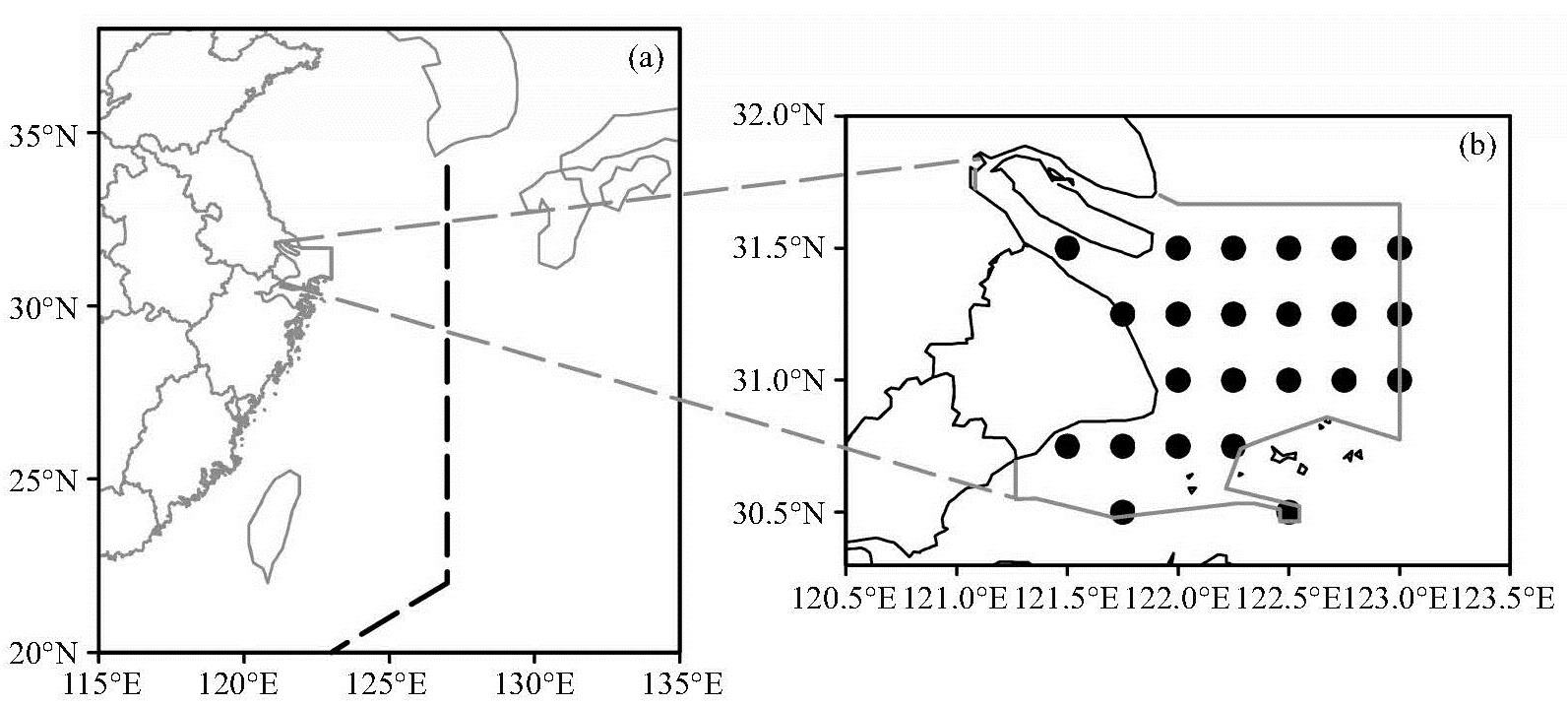Momentum Diagnostic Cause Analysis of Offshore North-ward Tropical Cyclone Gales in Shanghai Coastal Areas
-
摘要: 基于ERA5再分析资料和中国气象局(CMA)热带气旋(TC)最佳路径资料,统计分析1981—2022年中国近海北上TC造成上海沿岸水域大风特征,并进一步利用动量收支诊断方程对其进行定量化成因分析,结果表明:(1)不同TC最大影响风力存在较大差异,且TC到上海沿岸水域距离对其具有显著影响;(2)气压梯度力项(PGA)和垂直平流项(VA)是造成上海沿岸水域TC大风的主要动力机制,其中PGA项贡献最大,VA项次之,且风力越大,PGA和VA项的强度越强;(3)气压梯度增强引起PGA项增强,同时,边界层急流内高动量通过动量下传作用引起边界层上方VA项的增强,最终导致上海沿岸水域产生TC大风。本研究结果对TC大风的预报有重要指导意义,并具有重要实际业务应用价值,从而为防灾减灾提供科学依据。Abstract: Based on the ERA5 reanalysis data and China Meteorological Administration (CMA) tropical cyclone best track data from 1981 to 2022, this study analyzes the gale characteristics induced by offshore and northward-moving tropical cyclones (TCs) in Shanghai coastal areas. A quantitative momentum budget diagnostic equation is then utilized to investigate their dynamic mechanisms. The results show that: (1) Substantial discrepancy exists in the maximum impact wind intensities among different TCs, and the intensities are strongly affected by the distance of the TCs from Shanghai coastal waters. (2) The pressure gradient acceleration (PGA) and the vertical advection (VA) terms are the primary dynamical mechanisms for TC gales in Shanghai coastal areas. The PGA term accounts for the major contribution, followed by the VA term, with the intensity of both terms strengthen with wind intensities. (3) Enhanced pressure gradient directly strengthens the PGA term, while the downward transport of high momentum from the boundary layer jet amplifies the VA term above the boundary layer, ultimately driving the TC gales in the Shanghai coastal areas. These results establish important guidance for TC gale forecasting and have practical value for operational applications, thereby offering a scientific basis for disaster prevention and mitigation.
-
表 1 影响上海沿岸水域并产生大风的近海北上TC信息
序号 台风编号 影响开始时间/UTC 影响结束时间/UTC 影响最强时刻/UTC 最强时刻TC强度 最大影响风力/级 1 198118 1981083018 1981090319 1981083116 STY 9 2 198211 1982081004 1982081318 1982081209 STS 9 3 198310 1983092514 1983092804 1983092622 SuperTY 10 4 198410 1984081815 1984082102 1984082000 TY 8 5 198520 1985100323 1985100515 1985100416 TY 8 6 198613 1986082522 1986082810 1986082707 TY 10 7 198616 1986091819 1986092022 1986092010 STS 7 8 198705 1987071418 1987071510 1987071423 STY 6 9 198712 1987083003 1987083014 1987083008 TY 6 10 199413 1994080805 1994081107 1994080821 TY 7 11 199429 1994101003 1994101121 1994101107 STS 8 12 199809 1998092908 1998093015 1998092916 TY 7 13 199917 1999091612 1999091900 1999091702 STS 7 14 200012 2000082902 2000083106 2000083013 TY 9 15 200014 2000091109 2000091522 2000091318 STY 8 16 200205 2002070319 2002070520 2002070412 TY 9 17 200314 2003091022 2003091211 2003091202 STY 6 18 200415 2004081720 2004081821 2004081807 TY 7 19 200712 2007091502 2007091602 2007091518 TY 6 20 201010 2010090501 2010090522 2010090517 STS 6 21 201105 2011062423 2011062605 2011062520 STS 7 22 201109 2011080518 2011080714 2011080621 TY 10 23 201215 2012082616 2012082804 2012082713 TY 9 24 201315 2013083010 2013083019 2013083013 TS 6 25 201408 2014070812 2014070912 2014070818 STY 8 26 201412 2014073103 2014080221 2014080112 STS 7 27 201509 2015070919 2015071209 2015071104 STY 9 28 201819 2018082209 2018082310 2018082217 TY 6 29 201825 2018100405 2018100606 2018100507 STS 9 30 201905 2019071900 2019072222 2019071906 TS 6 31 201913 2019090603 2019090623 2019090612 STY 8 32 201917 2019092011 2019092218 2019092115 TY 8 33 201918 2019100101 2019100212 2019100112 TY 8 34 202008 2020082508 2020082610 2020082519 STY 7 35 202009 2020090102 2020090217 2020090120 STY 6 36 202114 2021091211 2021091620 2021091312 STY 9 37 202211 2022090402 2022090521 2022090504 SuperTY 8 -
[1] 陈联寿, 丁一汇. 西北太平洋台风概论[M]. 北京: 科学出版社, 1979. [2] POWELL M D, DODGE P P, BLACK M L. The landfall of hurricane Hugo in the Carolinas: surface wind distribution[J]. Wea Forecasting, 1991, 6(3): 379-399. [3] 田辉, 马开玉, 林振山. 华南、华东沿海登陆台风暴雨和大风的分析[J]. 应用气象学报, 1999, 10(S1): 149-153. [4] 杨玉华, 雷小途. 我国登陆台风引起的大风分布特征的初步分析[J]. 热带气象学报, 2004, 20(6): 633-642. [5] 梁莉, 崔晓鹏, 王成鑫, 等. 我国登陆热带气旋引起的大陆地面风场分布[J]. 大气科学, 2018, 42(1): 96-108. [6] 刘婧茹, 李英, 孟青, 等. 中国东南地区热带气旋大风及其伴随天气的统计特征[J]. 大气科学, 2023, 47(4): 1 024-1 038. [7] 林小红, 吴幸毓, 陈淼, 等. 台湾海峡西岸台风大风特征及极端大风典型个例分析[J]. 气象与环境学报, 2019, 35(6): 93-100. [8] 王丽娟, 邓方俊, 史珩瑜, 等. 1909号台风"利奇马"影响期间浙江大风分布特征及成因分析[J]. 海洋预报, 2020, 37(6): 83-95. [9] 植江玲, 黄先香. 1713号台风"天鸽"与1822号台风"山竹"大风过程对比及成因分析[J]. 中低纬山地气象, 2020, 44(5): 54-60. [10] 邱王泽禾, 章蓝文. 1917号台风"塔巴"对浙江沿海风场的影响及其成因分析[J]. 应用海洋学学报, 2021, 40(2): 332-341. [11] XUE L, LI Y, YAO S. A Statistical analysis of tropical cyclone-induced low-level winds near Taiwan Island[J]. Atmosphere, 2023, 14(4): 715. [12] 郑焘, 李晴岚, 王兴宝, 等. 台风对深港局地风影响数值模拟及地形敏感性试验[J]. 气象, 2018, 44(3): 361-371. [13] 董浩天, 陶韬, 杜晓庆. 沿海复杂地形台风登陆过程风场多尺度数值模拟[J]. 空气动力学学报, 2021, 39(4): 147−152. [14] WU L G, LIU Q Y, LI Y B. Prevalence of tornado-scale vortices in the tropical cyclone eyewall[J]. Pro Natl Acad Sci, 2018, 115(33): 8 307-8 310. [15] WU L G, LIU Q Y, LI Y B. Tornado-scale vortices in the tropical cyclone boundary layer: numerical simulation with the WRF-LES framework[J]. Atmos Chem Phys, 2019, 19(4): 2 477-2 487. [16] 邵颖斌, 毕潇潇, 刘锦绣, 等. 1617超强台风"鲇鱼"大风成因和预报分析[J]. 海峡科学, 2017, (12): 8-13. [17] 陈龚梅, 罗厚炙. 1909台风"利奇马"大风成因分析[J]. 民航学报, 2021, 5(6): 67-70+123. [18] 胡潇杰, 俞宏耀, 於敏佳. 台风"黑格比"近海加强成因及对比分析[J]. 现代农业科技, 2021, (9): 187-190+193. [19] 陈德花, 张玲, 张伟, 等. "莫兰蒂"台风致灾大风的结构特征及成因[J]. 大气科学学报, 2018, 41(5): 692-701. [20] JOHNS R H, DOSWELL C A. Severe local storms forecasting[J]. Wea Forecasting, 1992, 7(4): 588-612. [21] MECHEM D B, CHEN S S, HOUZE R A. Momentum transport processes in the stratiform regions of mesoscale convective systems over the western Pacific warm pool[J]. Quart J Roy Meteo Soc, 2006, 132(616): 709-736. [22] MAHONEY K M, LACKMANN G M, PARKER M D. The role of momentum transport in the motion of a quasi-idealized mesoscale convective system[J]. Mon Wea Rev, 2009, 137(10): 3 316-3 338. [23] 岳彩军, 袁招洪, 陶岚, 等. 上海地区一次阵风锋结构特征与动量收支诊断分析[J]. 高原气象, 2016, 35(3): 788-799. [24] 吉会峰, 刘吉堂, 高清清, 等. ERA5风场资料在江苏近岸海域的初步评估[J]. 海洋通报, 2021, 23(2): 21-35. [25] HAN Z H, YUE C J, LIU C H, et al. Evaluation on the applicability of ERA5 reanalysis dataset to tropical cyclones affecting Shanghai[J]. Front Earth Sci, 2022, 16(4): 1 025-1 039. [26] SLOCUM C J, RAZIN M N, KNAFF J A, et al. Does ERA5 mark a new era for resolving the tropical cyclone environment?[J]. J Climate, 2022, 35(21): 7 147-7 164. [27] XIONG J, YU F J, Fu C F, et al. Evaluation and improvement of the ERA5 wind field in typhoon storm surge simulations[J]. Appl Ocean Res, 2022, 118: 103000. [28] BIAN G F, NIE G Z, QIU X. How well is outer tropical cyclone size represented in the ERA5 reanalysis dataset?[J] Atmos Res, 2021, 249: 105339. [29] 于玲玲, 麦健华, 程正泉, 等. 热带气旋大风风圈半径非对称性特征及成因简析[J]. 气象学报, 2022, 80(6): 896-908. [30] LU X Q, YU H, YING M, et al. Western North Pacific tropical cyclone database created by the China Meteorological Administration[J]. Adv Atmos Sci, 2021, 38(4): 690−699. [31] YING M, ZHANG W, YU H, et al. An overview of the China Meteorological Administration tropical cyclone database[J]. J Atmos Oceanic Technol, 2014, 31(2): 287-301. [32] 中国气象局. 热带气旋等级: GB/T 19201—2006 [S]. 北京: 中国标准出版社, 2006. [33] 岳彩军, 寿绍文, 曾刚, 等". 海棠"台风(2005)雨强差异成因分析[J]. 气象科学, 2010, 30(1): 1-7. [34] 朱乾根, 林锦瑞, 寿绍文, 等. 天气学原理和方法[M]. 北京: 气象出版社, 2007. [35] 寿绍文, 岳彩军, 寿亦萱, 等. 现代天气学方法[M]. 北京: 气象出版社, 2023. [36] 刘月贞, 丁一汇, 陶诗言. 热力强迫对台风次级环流的作用[J]. 气象学报, 1988, 46(4): 432-444. [37] LI Q, WANG Y, DUAN Y. A numerical study of outer rainband formation in a sheared tropical cyclone[J]. J Atmos Sci, 2017, 74(1): 203-227. -






 下载:
下载:









 粤公网安备 4401069904700003号
粤公网安备 4401069904700003号